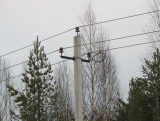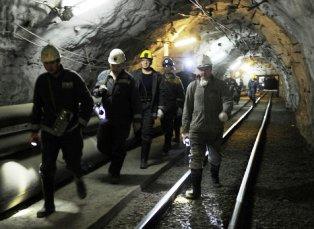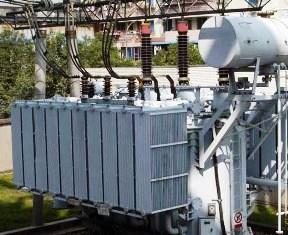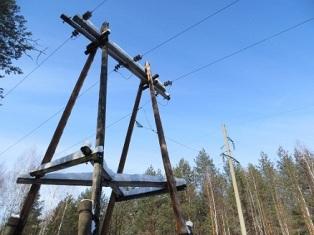The use of electrical networks with an isolated neutral
 An isolated neutral is the neutral of a transformer or generator that is not connected to an earthing device or is connected to it through a high resistance.
An isolated neutral is the neutral of a transformer or generator that is not connected to an earthing device or is connected to it through a high resistance.
Electrical networks with isolated neutral are used in electrical networks with voltages of 380 — 660 V and 3 — 35 kV.
Application of networks with isolated neutral at voltage up to 1000 V
Three-wire electrical networks with isolated neutral are used at a voltage of 380 — 660 V, when it is necessary to comply with the increased requirements for electrical safety (electrical networks of coal mines, potash mines, peat mines, mobile installations). Networks of mobile electrical installations can be implemented with four wires.
In normal operation, the voltages of the network phases to ground are symmetrical and numerically equal to the phase voltage of the installation, and the currents in the source phases are equal to the phase load currents.
In networks with a voltage of up to 1 kV (as a rule, short lengths), the capacitive conductivity of the phases relative to the ground is neglected.
When a person touches the phase of the network, the current passes through his body
Azh = 3Uf / (3r3+ z)
where Uf — phase voltage; r3 — the resistance of the human body (taken equal to 1 kΩ); z — impedance from Isolation of the phase to ground (100 kΩ or more per phase).
Since z >>r3, current I is negligibly small. Therefore, it is relatively safe for a person to touch the phase. It is this circumstance that determines the use of an isolated neutral in the electrical installations of those objects whose premises, from the point of view of the danger of electric shock to people, are classified as particularly dangerous or of increased danger.

In the case of defective insulation, when z << rz, a person, touching the phase, falls under the phase voltage. In this case the current. passage through the human body may exceed the lethal value.
In single-phase earth faults, the voltage of the faulted phases relative to the ground increases linearly, and the current passing through the human body when it touches the intact phase at the moment of a short circuit is always dangerous, as it reaches several hundred milliamperes (here z << rз and instead of the value The Uf value of the line voltage must be substituted in the formula, i.e. √3.
A consequence of the above is the use in such networks as a protective measure of protective disconnection or grounding in combination with condition monitoring isoltion networks. Long-term operation of the network with single-phase earth faults is not allowed in these electrical installations.
The basis for the use of grounding in combination with cross-sectional insulation monitoring is the fact that the solid earth fault current Ic in networks with an isolated neutral, it does not depend on the grounding resistance of the housings of electrical equipment, which are not normally energized (due to the fact that the conductivity of the grounding point is significantly higher than the sum of the conductivity of the neutral, insulation and phase capacity relative to the ground), and the voltage of the damaged phase relative to the ground Uz is a small part of the phase voltage of the source.
Values of the quantities AzSand Uz for symmetrical resistances insulation relative to the ground is determined as follows:
Azh = 3Uf /z, Uz = Ažs x rz = 3Uφ x (rz/ z)
where rz — grounding resistance of electrical equipment housings. Since z >> rz, then Uz << Uf.
As can be seen from the formulas, in networks with an isolated neutral, the short-circuit of one phase to ground does not cause short-circuit currents, the current I is several milliamperes. Protective shutdown ensures automatic shutdown of the electrical installation in the event of an electric shock and in underground networks is based on automatic monitoring of the condition of the insulation.

Application of networks with isolated neutral at voltages above 1000 V
Three-wire electrical networks with a voltage of more than 1 kV with an isolated neutral (with low grounding currents) include networks with a voltage of 3 — 33 kV. Here, the capacitive conductance of the phases with respect to ground cannot be neglected.
In normal mode, the currents in the phases of the source are determined by the geometric sum of loads and capacitive currents of the phases with respect to the ground. The geometric sum of the capacitive currents of the three phases is equal to zero, therefore no current flows through the ground.
In a solid earth fault, the voltage to earth of this faulted phase becomes approximately equal to zero., and the voltages to earth of the other two (faulted) phases increase to linear values. Capacitive currents of undamaged phases also increase √3 times, since not phase, but line voltages are now applied to the phase capacitances. As a result, the capacitive current of a single-phase earth fault turns out to be 3 times the normal capacitive current per phase.
The absolute value of these currents is relatively small. So, for an overhead power line with a voltage of 10 kV and a length of 10 km, the capacitive current is NSabout 0.3 A., and for a cable line with the same voltage and length — 10 A.

The use of a three-wire network with a voltage of 3 — 35 kV with an isolated neutral is not due to the requirements for electrical safety (such networks are always dangerous for people) and the ability to ensure the normal operation of electrical receivers connected to phase-phase voltage for a certain period of time. The fact is that with single-phase earth faults in networks with an isolated phase-neutral, the phase-to-phase voltage remains unchanged in magnitude and the phase is shifted by an angle of 120 °.
The voltage rise in undamaged phases to a linear value extends until everything is there, and with prolonged exposure, insulation damage and a subsequent short circuit between the phases are possible.Therefore, in such networks, in order to quickly find earth faults, automatic insulation control should be carried out, acting on the signal when the insulation resistance of one of the phases falls below a predetermined value.
In networks supplying substations of mobile installations, peat mines, coal minesT and In potash mines, earth fault protection must operate to disconnect.
When a phase is closed to the ground by an arcing arc, resonance phenomena and dangerous overvoltages up to (2.5 — 3.9) Uph, which, with weakened insulation, lead to its failure and short circuit. Therefore, the level of line isolation is determined by the frequency of resonant overvoltages.
Interrupting arcs occur in networks with capacitive earth fault currents above 10 and 15 A at voltages of 35 and 20 kV, respectively, above 20 and 30 A at voltages of 6 and 10 kV, respectively.
To eliminate the possibility of intermittent arcs and to eliminate the associated dangerous consequences for insulation electrical equipment in the neutral part of a three-wire network includes an inductive arc suppression reactor… The inductance of the reactor is chosen in such a way that the capacitive current at the location of the earth fault is as small as possible and at the same time guarantees the operation of the relay protection that reacts to a single-phase earth fault.
M.A. Korotkevich
